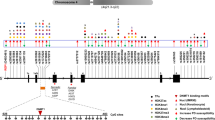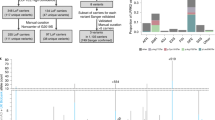Abstract
We identified a marker in LINGO1 showing genome-wide significant association (P = 1.2 × 10−9, odds ratio = 1.55) with essential tremor. LINGO1 has potent, negative regulatory influences on neuronal survival and is also important in regulating both central-nervous-system axon regeneration and oligodendrocyte maturation. Increased axon integrity observed in Lingo1 mouse knockout models highlights the potential role of LINGO1 in the pathophysiology of essential tremor.
This is a preview of subscription content, access via your institution
Access options
Subscribe to this journal
Receive 12 print issues and online access
$209.00 per year
only $17.42 per issue
Buy this article
- Purchase on Springer Link
- Instant access to full article PDF
Prices may be subject to local taxes which are calculated during checkout

Similar content being viewed by others
Change history
24 March 2009
NOTE: In the version of this article initially published, one sentence in the abstract and two sentences in the final paragraph of the paper were in error and have been modified. The final sentence in the abstract should read: Increased axon integrity observed in Lingo1 mouse knockout models highlights the potential role of LINGO1 in the pathophysiology of ET. The final three sentences of the paper should read: Axonal swellings of Purkinje cell are considered to be one of the pathological findings in essential tremor6. Increased axon integrity observed in LINGO1 mouse knockout models16 highlights the potential role of LINGO1 in the pathophysiology of ET and opens up a new field in the research into essential tremor. It is our hope that LINGO1 will point the way to new treatments for severe cases of the disease. Finally, one reference has been added: 16. Mi, S. et al. Nat. Med. 13, 1228–1233 (2007). These errors have been corrected in the HTML and PDF versions of the article.
References
Louis, E.D. & Dogu, O. Neuroepidemiology 29, 208–212 (2007).
Bain, P.G. et al. Brain 117, 805–824 (1994).
Louis, E.D. Lancet Neurol. 4, 100–110 (2005).
Moghal, S., Rajput, A.H., D'Arcy, C. & Rajput, R. Neuroepidemiology 13, 175–178 (1994).
Deuschl, G., Wenzelburger, R., Loffler, K., Raethjen, J. & Stolze, H. Brain 123, 1568–1580 (2000).
Louis, E.D. et al. Brain 130, 3297–3307 (2007).
Shill, H.A. et al. Neurology 70, 1452–1455 (2008).
Devlin, B. & Roeder, K. Biometrics 55, 997–1004 (1999).
Laursen, L.S. & Ffrench-Constant, C. Neuron Glia Biol. 3, 367–375 (2007).
Mi, S., Sandrock, A. & Miller, R.H. Int. J. Biochem. Cell. Biol. 40, 1971–1978 (2008).
Zhao, X.H., Jin, W.L., Wu, J., Mi, S. & Ju, G. Cell. Mol. Neurobiol. 28, 727–735 (2008).
Deng, H., Le, W. & Jankovic, J. Brain 130, 1456–1464 (2007).
Oliver, P.L. & Davies, K.E. Clin. Sci. (Lond.) 108, 385–397 (2005).
Llorens, F. et al. Dev. Neurobiol. 68, 521–541 (2008).
Mantel, N. & Haenszel, W. J. Natl. Cancer Inst. 22, 719–748 (1959).
Mi, S. et al. Nat. Med. 13, 1228–1233 (2007).
Acknowledgements
We thank the individuals taking part in this study whose contribution made this work possible. We also thank the Nurses at Krókháls (deCODE's recruitment center) and the personnel at the deCODE core facilities. The US sample was recruited through support from Emory General Clinical Research Center NIH/NCRR M01 RR00039 (CRIN Infra-structure support).
Author information
Authors and Affiliations
Contributions
The study was designed and results were interpreted by H.S., K.S., A.K., S.S., T.J., H.P., D.H. and J.G. Subject ascertainment and recruitment was carried out by K.S., J.B., J.G., F.J., K.K., M.D., L.S., F.A., A.R.R., L.A.M., C.M.T., C.H., E.A., A.Z., D.R., G.B., D.H. and G.A.J. Genotyping and laboratory experiments were performed by T.T., J.S., S.T.P., G.A.J., O.G., U.T., Y.B. and I.H.G. Authors H.S., K.S., S.S., O.G. and Y.B. drafted the manuscript. All authors contributed to the final version of the paper.
Corresponding author
Ethics declarations
Competing interests
Some of the authors, including Kari Stefansson (CEO of deCODE genetics), Jeffrey Gulcher (Chief Scientific Officer) and Augustine Kong (VP Statistics), are shareholders in deCODE genetics.
Supplementary information
Supplementary Text and Figures
Supplementary Methods, Supplementary Tables 1–4 and Supplementary Figures 1–3 (PDF 622 kb)
Rights and permissions
About this article
Cite this article
Stefansson, H., Steinberg, S., Petursson, H. et al. Variant in the sequence of the LINGO1 gene confers risk of essential tremor. Nat Genet 41, 277–279 (2009). https://doi.org/10.1038/ng.299
Received:
Accepted:
Published:
Issue Date:
DOI: https://doi.org/10.1038/ng.299
This article is cited by
-
Early-onset familial essential tremor is associated with nucleotide expansions of spinocerebellar ataxia in China
Molecular Biology Reports (2024)
-
Association Analysis of 27 Single Nucleotide Polymorphisms in a Chinese Population with Essential Tremor
Journal of Molecular Neuroscience (2023)
-
Han family with essential tremor caused by the P421L variant of the TENM4 gene in China
Neurological Sciences (2023)
-
Gene Expression Analysis of Laser-Captured Purkinje Cells in the Essential Tremor Cerebellum
The Cerebellum (2022)
-
Investigation of the risk of valproic acid–induced tremor: clinical, neuroimaging, and genetic factors
Psychopharmacology (2022)



